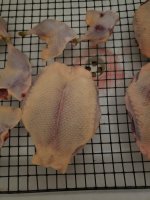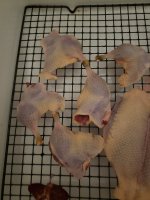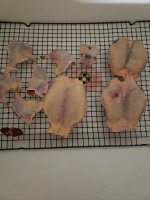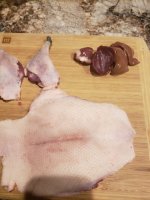Navigation
Install the app
How to install the app on iOS
Follow along with the video below to see how to install our site as a web app on your home screen.
Note: This feature may not be available in some browsers.
More options
Style variation
You are using an out of date browser. It may not display this or other websites correctly.
You should upgrade or use an alternative browser.
You should upgrade or use an alternative browser.
The Deer Aging Thread
- Thread starter robby denning
- Start date
Enjoyed this a lot. Shared forum knowledge and experience at its best.
One person mentioned wet aging. Not the same thing or course, but I read a paper recently that showed that wet aging after freezing is just as effective as before (on beef, but I imagine it would hold for venison). In other words, if you didn’t manage to age the deer first, just let your steak thaw in the fridge for a while after freezing, and you’ll have a nice tender meal! Not like the dry aged flavor, I’m sure, but still good.
The nice thing about this is that you don’t have to age an entire carcass at once; you can age each bit as you like. The downside, I guess, is it that you have to plan pretty far ahead for each meal.
Should mention that the paper didn’t freeze anything in the first 2 days after slaughter. Not sure if that matters, but it might (given rigor mortis and all that).
One person mentioned wet aging. Not the same thing or course, but I read a paper recently that showed that wet aging after freezing is just as effective as before (on beef, but I imagine it would hold for venison). In other words, if you didn’t manage to age the deer first, just let your steak thaw in the fridge for a while after freezing, and you’ll have a nice tender meal! Not like the dry aged flavor, I’m sure, but still good.
The nice thing about this is that you don’t have to age an entire carcass at once; you can age each bit as you like. The downside, I guess, is it that you have to plan pretty far ahead for each meal.
Should mention that the paper didn’t freeze anything in the first 2 days after slaughter. Not sure if that matters, but it might (given rigor mortis and all that).
Not sure if this adds much to the thread, but here's a recap of my experience (so far) with aging:
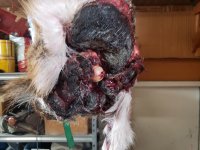
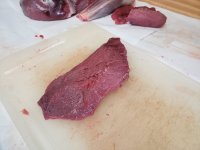
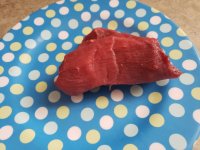
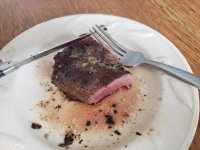
- 12/6/20 - shot whitetail doe/brought home for self-processing/two rear legs removed in the field, front half--spine, loins, front legs, neck, and head--all remain intact and brought home in one piece/hide was left on all three pieces (2 rear legs, 1 front half)/all three pieces hung from the rafters in my unheated, uninsulated, attached garage
- 12/9/20 through 12/11/20 - unseasonably warm daytime temps (50 degrees plus) meant my garage would be too warm to continue the aging process/all meat was taken down each morning, placed on old sheets on the cool concrete floor, frozen bottles of water placed in and around the entire carcass, and everything covered in old blankets during the day/each night the pieces would be removed and rehung since the inside garage temps fall to just above freezing at night/this process is repeated each day until daytime highs drop below 40 degrees
- 12/12/20 - primary butchering of the deer (6 days after being shot)/front half and one of two hind legs completely butchered, packed, and stacked in the freezer/one hind left to hang for the next several weeks
- 1/9/21 - remaining hind quarter butchered (34 days after being shot)/small piece cooked and eaten but majority packed and stacked int the freezer
- Topline: Based on what I've experienced I see no reason to shy away from 30+ days of aging
- The 34 day old sample piece of hindquarter I sampled after butchering 1/9/21 was seasoned with salt, pepper and cooked quickly on a cast-iron skillet, a pat of herbed butter was thrown on at the end as I let the meat rest for a few minutes after cooking. Flavor was very good, zero gamey-ness (sp?), very tender, I did not really detect any hint of "blue cheese" funkiness that you typically get from dry-aged beef
- Leaving the hide on seems to have been a wise move. The exposed flesh developed a notable rind/crust that was trimmed away so there was some (albeit minimal) loss, but what was underneath remained supple and looked great. Had I removed the hide right away there would have more crust to remove and thus more loss.
- There was just a hint of white mold beginning to form in a few spots. Nothing I wasn't expecting, but zero slime, off-color mold or any form of rotting stench was present. Anything other than the white stuff and I would have had real concerns, thankfully that wasn't the case
- This little experiment worked well enough that I'm weighing different options for temp control next season. Whether it's finding an old fridge, constructing a temporary insulated "chamber" of some sort for hunting season, or something more permanent. Basically, taking things up and down on warm days felt like a burden that could fairly easily be avoided in the future
- I don't yet feel 100% confident saying this was a slam dunk success. Reason being, 90% of that doe is still in the freezer, I just haven't consumed enough yet to say for certain. But based on everything outside of taste, I'd recommend anyone try it if you have the means. If you're curious but not sure, consider doing as I did, save a quarter to age, and process the rest on your normal timeline. Risk management





HuntInWild88
WKR
So I finished my aging on Sunday. So the 17th. I originally put the frozen solid quarters in the fridge on the 18th of December. I kept a pretty close eye one it as I was using a humidifier in the fridge to keep the humidity between 70-80%. 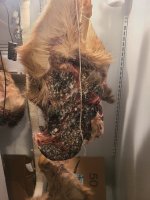 Everything seemed to go pretty good. I pulled it because I started to get a greenish yellow mold. I looked it up and everything I read said the colored mold was ok as long as it wasn't dark or black.
Everything seemed to go pretty good. I pulled it because I started to get a greenish yellow mold. I looked it up and everything I read said the colored mold was ok as long as it wasn't dark or black. 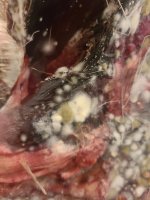
The meat under the rine was that darker dryer meat the Robby showed with his. However, the meat under the hide was starting to be almost brown. After removing the "brown" the neat under that was very moist and red. No blood just a clearing juicy. The meat looked and smelled great.
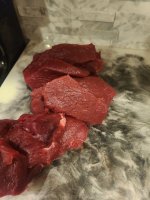 I fried up a couple of these steaks and the taste was fantastic! It was a little weird at first because I had never had aged meat. I was expecting it to taste like my normal deer steaks. However it a had a much richer flavor. As many have said kind of earthy tones if that makes any sense at all. Before I had had these steaks I had no clue what "earthy" tones ment. I will definitely be be aging all my deer from now on. However, I will remove the hide next time as I still had to trim about 1/4" off everything. Thanks again everyone on here and especially Robby for inspiring me with this thread.
I fried up a couple of these steaks and the taste was fantastic! It was a little weird at first because I had never had aged meat. I was expecting it to taste like my normal deer steaks. However it a had a much richer flavor. As many have said kind of earthy tones if that makes any sense at all. Before I had had these steaks I had no clue what "earthy" tones ment. I will definitely be be aging all my deer from now on. However, I will remove the hide next time as I still had to trim about 1/4" off everything. Thanks again everyone on here and especially Robby for inspiring me with this thread.
 Everything seemed to go pretty good. I pulled it because I started to get a greenish yellow mold. I looked it up and everything I read said the colored mold was ok as long as it wasn't dark or black.
Everything seemed to go pretty good. I pulled it because I started to get a greenish yellow mold. I looked it up and everything I read said the colored mold was ok as long as it wasn't dark or black. 
The meat under the rine was that darker dryer meat the Robby showed with his. However, the meat under the hide was starting to be almost brown. After removing the "brown" the neat under that was very moist and red. No blood just a clearing juicy. The meat looked and smelled great.
 I fried up a couple of these steaks and the taste was fantastic! It was a little weird at first because I had never had aged meat. I was expecting it to taste like my normal deer steaks. However it a had a much richer flavor. As many have said kind of earthy tones if that makes any sense at all. Before I had had these steaks I had no clue what "earthy" tones ment. I will definitely be be aging all my deer from now on. However, I will remove the hide next time as I still had to trim about 1/4" off everything. Thanks again everyone on here and especially Robby for inspiring me with this thread.
I fried up a couple of these steaks and the taste was fantastic! It was a little weird at first because I had never had aged meat. I was expecting it to taste like my normal deer steaks. However it a had a much richer flavor. As many have said kind of earthy tones if that makes any sense at all. Before I had had these steaks I had no clue what "earthy" tones ment. I will definitely be be aging all my deer from now on. However, I will remove the hide next time as I still had to trim about 1/4" off everything. Thanks again everyone on here and especially Robby for inspiring me with this thread.
Last edited:
I am into my 14th day of aging and by looking at the weather for the next 10 days, I will be able to get pretty close if not complete a full month of aging on this meat. All looks good so far. I had to place some plastic around the deer last week due to a little bit of rain and snow in the forecast which worked out well. The meat has not froze totally yet, just a little on the outside, and it has a nice dry outer layer. I can't wait to get my meat butchered and taste it. These days are now going slow.
So I finished my aging on Sunday. So the 17th. I originally put the frozen solid quarters in the fridge on the 18th of December. I kept a pretty close eye one it as I was using a humidifier in the fridge to keep the humidity between 70-80%. View attachment 254730Everything seemed to go pretty good. I pulled it because I started to get a greenish yellow mold. I looked it up and everything I read said the colored mold was ok as long as it wasn't dark or black. View attachment 254719
The meat under the rine was that darker dryer meat the Robby showed with his. However, the meat under the hide was starting to be almost brown. After removing the "brown" the neat under that was very moist and red. No blood just a clearing juicy. The meat looked and smelled great.
View attachment 254729I fried up a couple of these steaks and the taste was fantastic! It was a little weird at first because I had never had aged meat. I was expecting it to taste like my normal deer steaks. However it a had a much richer flavor. As many have said kind of earthy tones if that makes any sense at all. Before I had had these steaks I had no clue what "earthy" tones ment. I will definitely be be aging all my deer from now on. However, I will remove the hide next time as I still had to trim about 1/4" off everything. Thanks again everyone on here and especially Robby for inspiring me with this thread.
Yeah I think that’s why the original chef taught me this said just skin them, as you end up trimming them anyways.
Thanks for giving it a try and for everyone else that has too.
I’m surprise no one spoiled a deer yet, shows you that this must not be all that hard. Like the chef said, 33 to 40°, not much can go wrong. just watch for high humidity if you’re in an enclosed space.
Sent from my iPhone using Tapatalk
HuntInWild88
WKR
Yeah it was pretty easy having the fridge. The only thing I will need next time is a small fan for circulation. I was opening both doors twice a day with a floor fan blowing into it just to get fresh air in.Yeah I think that’s why the original chef taught me this said just skin them, as you end up trimming them anyways.
Thanks for giving it a try and for everyone else that has too.
I’m surprise no one spoiled a deer yet, shows you that this must not be all that hard. Like the chef said, 33 to 40°, not much can go wrong. just watch for high humidity if you’re in an enclosed space.
Sent from my iPhone using Tapatalk
But other than that the hardest part is the wait!
very helpful and thanks for taking the time to share your experiences. Hide on!Not sure if this adds much to the thread, but here's a recap of my experience (so far) with aging:
Observations/takeaways/notes:
- 12/6/20 - shot whitetail doe/brought home for self-processing/two rear legs removed in the field, front half--spine, loins, front legs, neck, and head--all remain intact and brought home in one piece/hide was left on all three pieces (2 rear legs, 1 front half)/all three pieces hung from the rafters in my unheated, uninsulated, attached garage
- 12/9/20 through 12/11/20 - unseasonably warm daytime temps (50 degrees plus) meant my garage would be too warm to continue the aging process/all meat was taken down each morning, placed on old sheets on the cool concrete floor, frozen bottles of water placed in and around the entire carcass, and everything covered in old blankets during the day/each night the pieces would be removed and rehung since the inside garage temps fall to just above freezing at night/this process is repeated each day until daytime highs drop below 40 degrees
- 12/12/20 - primary butchering of the deer (6 days after being shot)/front half and one of two hind legs completely butchered, packed, and stacked in the freezer/one hind left to hang for the next several weeks
- 1/9/21 - remaining hind quarter butchered (34 days after being shot)/small piece cooked and eaten but majority packed and stacked int the freezer
All pics are of the hindquarter after 34 days of aging. Hopefully, this adds something of value to this great thread. I'm happy to expand on any of this if it is helpful. Thanks everyone!
- Topline: Based on what I've experienced I see no reason to shy away from 30+ days of aging
- The 34 day old sample piece of hindquarter I sampled after butchering 1/9/21 was seasoned with salt, pepper and cooked quickly on a cast-iron skillet, a pat of herbed butter was thrown on at the end as I let the meat rest for a few minutes after cooking. Flavor was very good, zero gamey-ness (sp?), very tender, I did not really detect any hint of "blue cheese" funkiness that you typically get from dry-aged beef
- Leaving the hide on seems to have been a wise move. The exposed flesh developed a notable rind/crust that was trimmed away so there was some (albeit minimal) loss, but what was underneath remained supple and looked great. Had I removed the hide right away there would have more crust to remove and thus more loss.
- There was just a hint of white mold beginning to form in a few spots. Nothing I wasn't expecting, but zero slime, off-color mold or any form of rotting stench was present. Anything other than the white stuff and I would have had real concerns, thankfully that wasn't the case
- This little experiment worked well enough that I'm weighing different options for temp control next season. Whether it's finding an old fridge, constructing a temporary insulated "chamber" of some sort for hunting season, or something more permanent. Basically, taking things up and down on warm days felt like a burden that could fairly easily be avoided in the future
- I don't yet feel 100% confident saying this was a slam dunk success. Reason being, 90% of that doe is still in the freezer, I just haven't consumed enough yet to say for certain. But based on everything outside of taste, I'd recommend anyone try it if you have the means. If you're curious but not sure, consider doing as I did, save a quarter to age, and process the rest on your normal timeline. Risk management
View attachment 251974View attachment 251975View attachment 251976View attachment 251977
It's not much to add but I've started putting my upland birds in a paper bag in the back of the fridge for a week or so and I think they are a lot better. I've heard the old timer technique was to hang the birds in the woodshed by the head and when the body fell off then it was done. I haven't given that a try due to not having a good space but would be curious to.
yes, my buddy from England about puked when he saw me cooking fresh pheasant. "We hang 'em guts-in, upside down on the porch until green drips out their noses"It's not much to add but I've started putting my upland birds in a paper bag in the back of the fridge for a week or so and I think they are a lot better. I've heard the old timer technique was to hang the birds in the woodshed by the head and when the body fell off then it was done. I haven't given that a try due to not having a good space but would be curious to.
I couldn't stomach that move, but did notice ungutted pheasants in fridge for a week plus seems to improve flavor and tenderness.
Ugh, I think that's even worse than waiting for the head to fall off.We hang 'em guts-in, upside down on the porch until green drips out their noses"
willfrye027
WKR
- Joined
- Dec 4, 2018
- Messages
- 2,878
I wonder how many days it takes for the brown to show up under skin? I think I did about 9 days with a skin on buck this year and didn’t have to trim any brown or crust. We did a couple pigs skin on for about a week too. I think next year I will need to push it a few days longer and see if it gets any better! Love this thread..Yeah I think that’s why the original chef taught me this said just skin them, as you end up trimming them anyways.
Thanks for giving it a try and for everyone else that has too.
I’m surprise no one spoiled a deer yet, shows you that this must not be all that hard. Like the chef said, 33 to 40°, not much can go wrong. just watch for high humidity if you’re in an enclosed space.
Sent from my iPhone using Tapatalk
also been trying to improve the waterfowl and upland aging game. Killed 43 ducks this year so far and have been experimenting with aging time/temp. For me, 36-48 hours hung outside in the shade (40lows 60highs) is the right combination of enhanced flavor and tenderness for ducks. I like 24 hours for quail. Left a few ducks as long as 96 hours and had some unsavory flavors come into play. 48 hours felt like too long for the quail. It’s pretty dang warm down here this year so maybe if the temps stayed colder I could get away with longer..
I wonder how many days it takes for the brown to show up under skin? I think I did about 9 days with a skin on buck this year and didn’t have to trim any brown or crust. We did a couple pigs skin on for about a week too. I think next year I will need to push it a few days longer and see if it gets any better! Love this thread..
also been trying to improve the waterfowl and upland aging game. Killed 43 ducks this year so far and have been experimenting with aging time/temp. For me, 36-48 hours hung outside in the shade (40lows 60highs) is the right combination of enhanced flavor and tenderness for ducks. I like 24 hours for quail. Left a few ducks as long as 96 hours and had some unsavory flavors come into play. 48 hours felt like too long for the quail. It’s pretty dang warm down here this year so maybe if the temps stayed colder I could get away with longer..
try 33-40 in a fridge. bacteria grows rapidly much above that.
Sent from my iPhone using Tapatalk
How did the 30-day hindquarter compare to the 6-day hindquarter? In terms of flavor, tenderness.Not sure if this adds much to the thread, but here's a recap of my experience (so far) with aging:
Observations/takeaways/notes:
- 12/6/20 - shot whitetail doe/brought home for self-processing/two rear legs removed in the field, front half--spine, loins, front legs, neck, and head--all remain intact and brought home in one piece/hide was left on all three pieces (2 rear legs, 1 front half)/all three pieces hung from the rafters in my unheated, uninsulated, attached garage
- 12/9/20 through 12/11/20 - unseasonably warm daytime temps (50 degrees plus) meant my garage would be too warm to continue the aging process/all meat was taken down each morning, placed on old sheets on the cool concrete floor, frozen bottles of water placed in and around the entire carcass, and everything covered in old blankets during the day/each night the pieces would be removed and rehung since the inside garage temps fall to just above freezing at night/this process is repeated each day until daytime highs drop below 40 degrees
- 12/12/20 - primary butchering of the deer (6 days after being shot)/front half and one of two hind legs completely butchered, packed, and stacked in the freezer/one hind left to hang for the next several weeks
- 1/9/21 - remaining hind quarter butchered (34 days after being shot)/small piece cooked and eaten but majority packed and stacked int the freezer
All pics are of the hindquarter after 34 days of aging. Hopefully, this adds something of value to this great thread. I'm happy to expand on any of this if it is helpful. Thanks everyone!
- Topline: Based on what I've experienced I see no reason to shy away from 30+ days of aging
- The 34 day old sample piece of hindquarter I sampled after butchering 1/9/21 was seasoned with salt, pepper and cooked quickly on a cast-iron skillet, a pat of herbed butter was thrown on at the end as I let the meat rest for a few minutes after cooking. Flavor was very good, zero gamey-ness (sp?), very tender, I did not really detect any hint of "blue cheese" funkiness that you typically get from dry-aged beef
- Leaving the hide on seems to have been a wise move. The exposed flesh developed a notable rind/crust that was trimmed away so there was some (albeit minimal) loss, but what was underneath remained supple and looked great. Had I removed the hide right away there would have more crust to remove and thus more loss.
- There was just a hint of white mold beginning to form in a few spots. Nothing I wasn't expecting, but zero slime, off-color mold or any form of rotting stench was present. Anything other than the white stuff and I would have had real concerns, thankfully that wasn't the case
- This little experiment worked well enough that I'm weighing different options for temp control next season. Whether it's finding an old fridge, constructing a temporary insulated "chamber" of some sort for hunting season, or something more permanent. Basically, taking things up and down on warm days felt like a burden that could fairly easily be avoided in the future
- I don't yet feel 100% confident saying this was a slam dunk success. Reason being, 90% of that doe is still in the freezer, I just haven't consumed enough yet to say for certain. But based on everything outside of taste, I'd recommend anyone try it if you have the means. If you're curious but not sure, consider doing as I did, save a quarter to age, and process the rest on your normal timeline. Risk management
View attachment 251974View attachment 251975View attachment 251976View attachment 251977
How did the 30-day hindquarter compare to the 6-day hindquarter? In terms of flavor, tenderness.
Ended up not doing the comparison on New Years like I planned (didn't have the aged quarter cut up yet).
I thawed a bit of both aged and regular to have for dinner tonight for my wife and I. I'll make some notes and make a post on her thoughts and mine.
Ended up not doing the comparison on New Years like I planned (didn't have the aged quarter cut up yet).
I thawed a bit of both aged and regular to have for dinner tonight for my wife and I. I'll make some notes and make a post on her thoughts and mine.
Just realized I never updated this... we did the aged vs non-aged test. Basically, it was all really good. There was a difference between the two, but it wasn't profound. My wife claimed she couldn't really tell a difference. To me the aged cut was definitely less saturated than the non-aged portion. It's difficult to describe, it wasn't dry at all. It was just slightly less red and didn't create a puddle the way the non-aged portion did. Which makes perfect sense considering how long it hung...
Flavor was great for both, the difference in flavor was very subtle. But also keep in mind this was probably a 3.5-year-old doe taken in early December and not some rutted up old buck. Both pieces were extremely tender. I have to imagine the difference would be more profound if this was an animal that wasn't prime for eating.
All that being said, I'm a believer and am already scheming ways to step up my meat aging game for 2021. Not turning back.
Similar threads
- Replies
- 18
- Views
- 946
Featured Video
Latest Articles
- TT#64 Josh Boyd Elk Hunting Strategies for Every Season
- Aaron Davidson of Gunwerks
- TT#63 Dirk Durham’s Art of Elk Calling
- BIG Buck Stories with the Dirty Giants Podcast
- TT#62 Brian Barney Hunting Bulls without Calling
- Hoyt Alpha AX-2 SD Review
- Kuiu Kenai vs Outdoor Vitals Vario Hooded Jacket Review
- Hoyt RX-9 Ultra Review
- Hunting Vampire Bucks & Building an Optics Kit
- Darton Sequel ST2 35 Review

